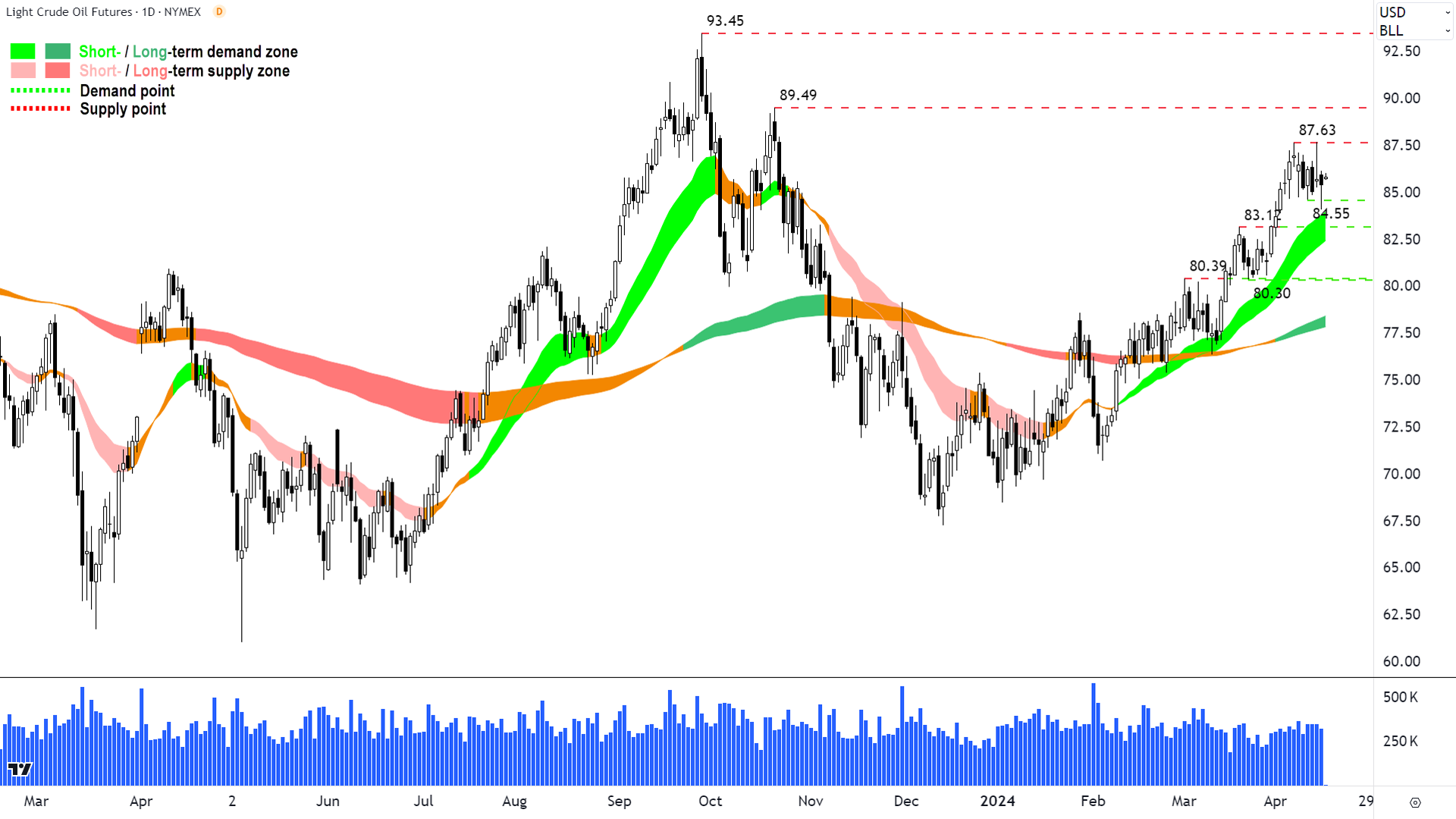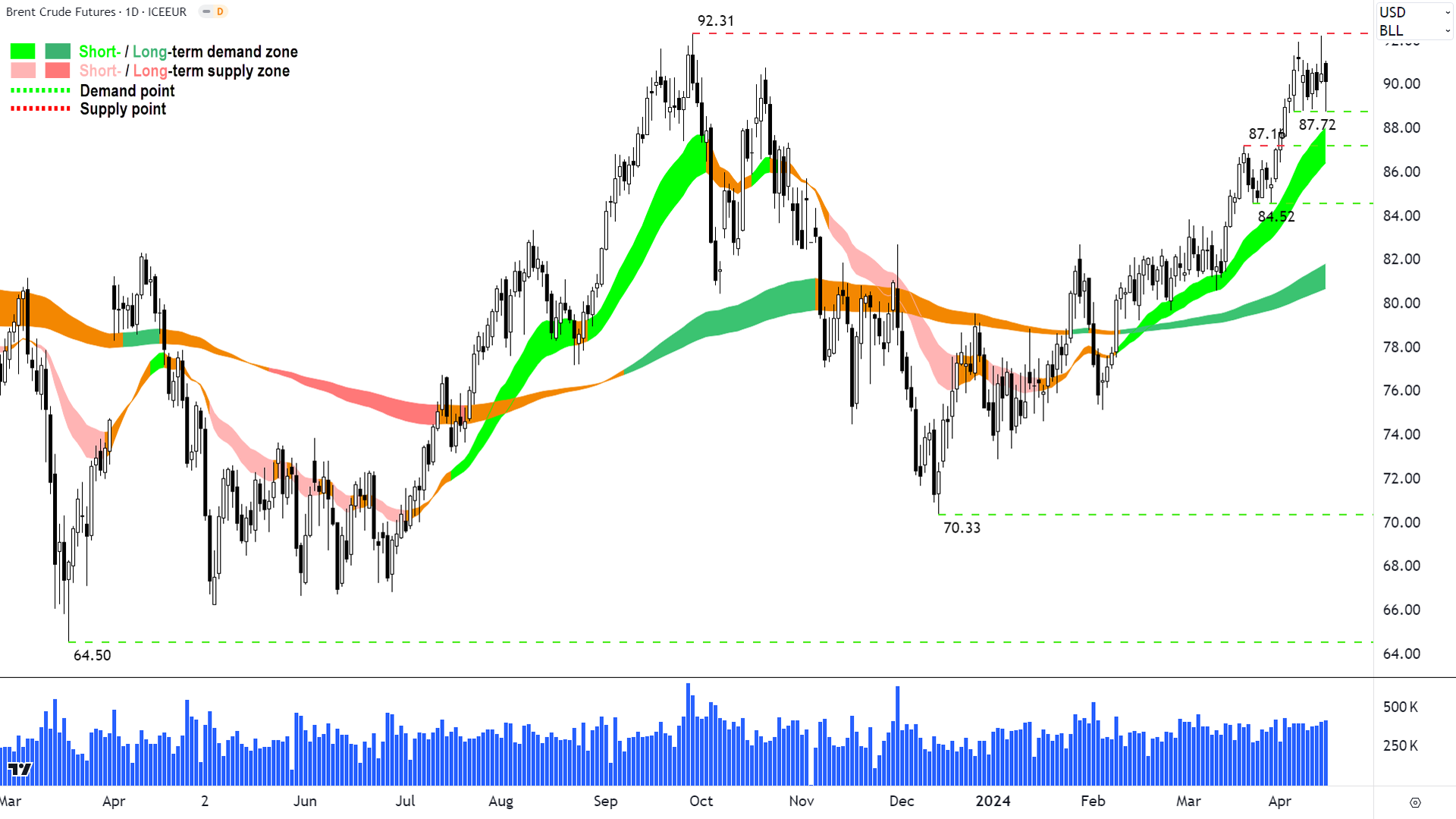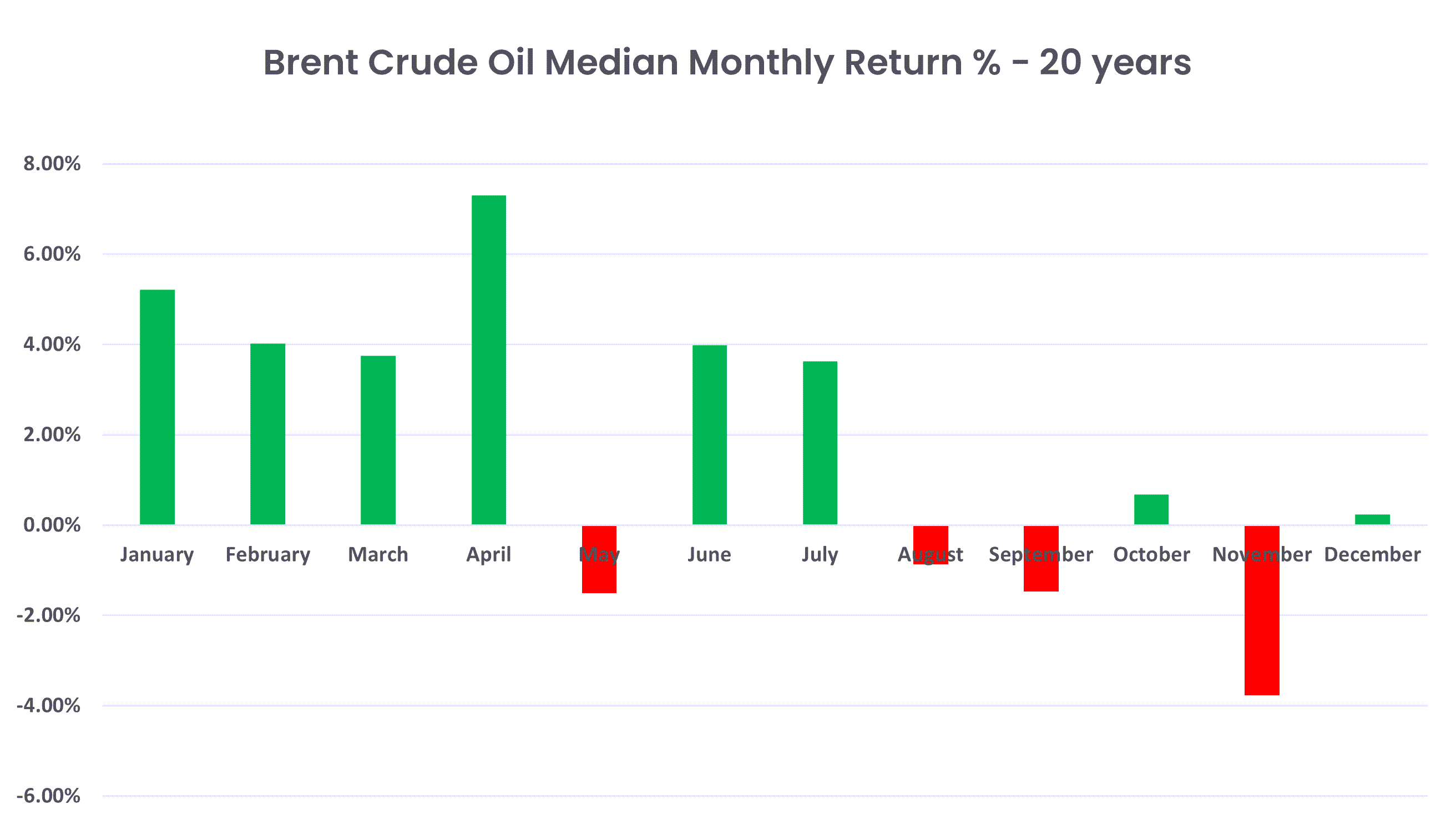Is the Mid-East conflict a lightning rod for another surge in crude oil prices?

Stocks in article
Commodities in article
Key Points
- Oil prices are rising after an escalation in the conflict in the Middle East
- Seasonally, April is a very strong time of the year for crude oil prices
- The technicals for crude oil look constructive for a continued move higher
It was an unusually busy weekend for traders. Not only did US stocks crumble on Friday under the weight of continued fears that rate cuts will be delayed until the end of the year, an escalation in the conflict in the Middle East stoked fears of an impending surge in crude oil prices.
Iran’s drone and missile attack on Israel escalates what was previously an internal conflict, to a cross-border affair with potentially wider ramifications. History is littered with large and sudden surges in oil prices due to geopolitical tensions, the most recent being the invasion of Ukraine by Russia in early 2022.
Let’s investigate how the charts, both seasonal and technical, are placed to either confirm or dispel the likelihood of a new bull market.
Oils ‘aint oils
It’s worth noting that not all oil contracts are going to move in the same way as a result of the problems in the Middle East. There are two major global crude oil contracts traded on global futures markets, West Texas Intermediate (WTI) and Brent. (There’s also Saudi Arabia’s Arab Light, but it is less traded on the major US and European exchanges.)
WTI is produced in the United States, and its futures price is the major reference price for American markets. In contrast, Brent is produced in the North Sea and its futures price is the major reference price for Europe, Africa, and Asia.

WTI crude oil price, daily chart. Source: TradingView
Check out the daily chart of WTI, above, and Brent, below. The clearest difference is that Brent is challenging its October 2023 highs, whereas WTI is still some way off.

Brent crude oil price, daily chart. Source: TradingView
In terms of performance, Brent also has the edge since the 13 December 2023 low:
1-week price performance: Brent -0.1% vs WTI -1.3%
1-month price performance: Brent +7.4% vs WTI +5.9%
13 December 2023 low performance: Brent +28.3% vs WTI +27.0%
In short, if you intend to trade a potential move in crude oil prices on the back of rising tensions in the Middle East, Brent will likely be the better of the two to target. Firstly, it’s the most likely to be impacted given sheer geographic proximity, and secondly (as a result of the first), it’s the one that has demonstrated the greatest price sensitivity to unfolding events.
Other technical analysis considerations why Brent is potentially the better of the two crude contracts to trade include:
Better established ST and LT trends (light and dark green trend ribbons)
Better price action (greater extensions on the up moves versus shallower pullbacks indicate more committed buy excess demand and buy the dip activity)
Greater size and frequency of demand-side candles (indicates more pervasive accumulation by market participants)
Closer to break out of October 2023 major point of supply (i.e., at 92.31, and therefore just the one major hurdle to overcome versus WTI needing to break above 89.49 and 93.45)
To get a better idea of the potential for a move up in Brent prices, it’s worth zooming out to the weekly chart. This shows what we can expect above $92.31. I can see an attractive base pattern forming above the long-term uptrend ribbon, with improving price action and predominantly demand-side candles—all typically checkmarks for continued strength.
The price is compressing beneath a major historical point of supply at $94.20, but after $94.20, there’s a relatively clear run to $107.37. I expect the zone between $107.37-114.21 will take some breaking, but above $114.21, there’s a vacuum in major supply points until the pre-GFC high of $132.74 (not shown in the weekly chart, please check the monthly chart).

Brent crude oil price, weekly chart. Source: TradingView
Timing is everything – lessons from seasonality
The move since October is largely going to plan in terms of seasonality. For those new to my seasonality articles, check out this page, which contains a comprehensive list of my recent work on the topic.
In short, seasonality is the tendency of certain assets to rise or fall consistently at certain times of the year. It’s best understood in agricultural commodities like wheat or coffee, where seasonal changes can have major impacts on demand and supply.
Crude oil prices are also highly seasonal, largely due to climatic seasons (i.e., when we like to keep warm or we like to go on driving holidays!). Seasonally, price weakness in both Brent and WTI is not uncommon in the back half of the year, while the front half of the year tends to yield price strength. The chart below shows the typical seasonal pattern for median monthly Brent returns over the last 20 years.

Brent crude oil seasonality median monthly performance last 20 years
Note that I have used median returns rather than average returns because crude oil markets are notoriously volatile, and there are several massive outlier months in the sample. For example, in April 2020, Brent fell 97% as the COVID pandemic struck, and then rallied over 1000% in May – from a negative (yes negative!) value.
The Brent seasonality chart indicates a high usually occurs around July-August with a low usually occurring around November-December. The months following this low are usually the strongest period of the year, until May, which is usually a down month. June and July are the next-most seasonally strong period of the year.
It’s fair to say that 2023 and the first few months of this year are so far pretty much going to the seasonal plan. In my experience this augurs well for continued seasonality.
If this is the case, then all things being equal (i.e., notwithstanding further complications from events in the Middle East), we are potentially approaching a seasonal dip in the Brent price. Approaching is the key word, though, as April is typically Brent’s strongest month with a median monthly gain of 7.3% – compare this to just a 3.7% gain so far. Contrasting this, over the last 20 years, May has delivered a median monthly loss of 1.5%.
It’s worth considering April is also the most reliable month for Brent strength, delivering a gain of any magnitude 77% of the time. Again, in contrast, May is the most reliable month for Brent to fall, delivering a loss of any magnitude 64% of the time.

Brent crude oil seasonality monthly gain reliability last 20 years
In conclusion, the technicals and seasonal trends suggest Brent could have more to go in the current run, potentially probing $94.20 before taking a modest breather, which could last until late May. In this scenario, $92.31 could act as a point of demand before a resumption of the prevailing long-term uptrend potentially pushes into $107.37 around June or July.
If we’re already at the seasonal peak, and $92.31 ends up capping, then I’d be watching out for excess demand to kick back in around the $87.16-87.72 support zone, and prices to push into 94.20 (and potentially beyond) around June or July.
Important, please note! This is just my analysis based on the data – remember, the future is unknown!
How to trade the next (maybe) surge in crude oil prices
If you’re looking to trade the next big bull market in crude oil prices, these are your main options (please note, I am not advocating for any of these approaches. I’m merely laying out the options):
1. Crude Oil Index ETF (ASX: OOO)
An ASX-listed ETF aims to track the price of WTI futures, hedged for moves in the AUDUSD.
Pro’s
It’s easy! You can trade OOO from your share trading platform in the same way as you might buy Woodside or Santos
No minimum investment (apart from usual ASX minimums)
Currency hedged, if you’re long OOO, an appreciation in the AUD will hurt your profits, which, based upon the underlying assets of the fund, are earned in USD
Con’s
Tracking error, price moves may not completely reflect moves in the underlying futures market
WTI is unlikely to move as well as Brent in response to escalations in Middle East tensions
2. Contracts for Difference (CFDs)
CFDs aim to replicate a trade in an underlying security, such as a stock, index, or commodity. Many major stock brokers also offer CFDs, but a separate CFD account is usually required.
Pro’s
Access to both Brent and WTI
Generally trading at same prices as underlying futures contracts, so minimal risk of tracking error
Tailor your exposure, i.e., generally can access via mini or micro contracts and so much smaller initial margin compared to underlying futures contracts
Commission free
Con’s
Long positions will attract a financing charge, shorts may attract a financing charge
Could get a margin call if the trade goes against the trader
3. Futures
Futures are contracts between two parties to transact in an agreed quantity and quality of an underlying asset at an agreed time in the future. Futures are traded through futures brokers only.
Pro’s
Trade both Brent and WTI
Direct exposure, you will get the full benefit of any move in Brent or WTI
Con’s
Traded in standard contracts, usually around US$5,000 for a standard contract (around 20% for mini contract)
Could get a margin call if the trade goes against the trader
Need to open a Futures account with a futures broker
4. Buy an oil stock
This is the riskiest way to trade a rise in oil prices, as oil stocks are subject to all the risks of the underlying commodity, as well as the operational risk of the company. It is possible the oil price rockets, yet an operational issue specific to the oil stock you purchased causes it to fall. We’ve all been there…(with oil, gold, copper etc.). Enough said!
Get the latest news and insights direct to your inbox
